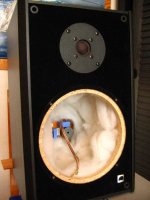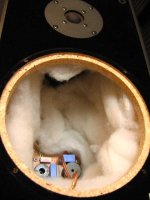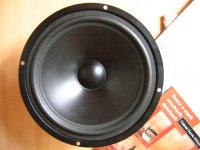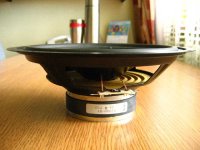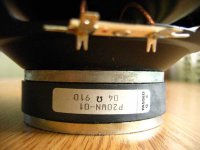Hi all.
I bought 2 used pairs of 2-way standmount speakers these are made from now discontinued German manufacturer ARCUS (AS 4 model).
I'm going to make new cabinets as the original ones were partially damaged (one pair was damaged from the original owner, the other has some corner damage during shipping). The drivers are 1" SEAS soft dome tweeter and 8" Vifa polypropylene woofer. The design is bass-reflex with a 69mm tapered to 60mm diameter, 192mm long plastic port at the back. Internal dimensions are 38.6 x 21.1 x 21 cm (HxWxD) so internal volume is 17.1lt (16.46lt without port volume)
They sound good and neutral, only a bit bass heavy, I would say the bass sometimes covers the other frequencies with it's power.
I read an article that more internal volume up to a limit, makes low frequencies more flat, so since I am very good at cabinet constraction but know almost nothing on electrical parameters I would appreciate any advice.
If I make new enclosures of about 25lt Internal volume what is about to change;
I bought 2 used pairs of 2-way standmount speakers these are made from now discontinued German manufacturer ARCUS (AS 4 model).
I'm going to make new cabinets as the original ones were partially damaged (one pair was damaged from the original owner, the other has some corner damage during shipping). The drivers are 1" SEAS soft dome tweeter and 8" Vifa polypropylene woofer. The design is bass-reflex with a 69mm tapered to 60mm diameter, 192mm long plastic port at the back. Internal dimensions are 38.6 x 21.1 x 21 cm (HxWxD) so internal volume is 17.1lt (16.46lt without port volume)
They sound good and neutral, only a bit bass heavy, I would say the bass sometimes covers the other frequencies with it's power.
I read an article that more internal volume up to a limit, makes low frequencies more flat, so since I am very good at cabinet constraction but know almost nothing on electrical parameters I would appreciate any advice.
If I make new enclosures of about 25lt Internal volume what is about to change;
If you increase the internal volume you'll change the tuning if you don't recalculate the dimensions of the port.
I would highly recommend simulating the box with WinISD or similar to see what changing the volume is going to do to the response. It could make it even more boomy. I suspect if there is too much bass output, a better tweak will be to lower the tuning by a couple of Hz and keep the volume the same. Putting a bit of fill material (wool or polyester stuffing) in the port and inside the box will also work.
I would highly recommend simulating the box with WinISD or similar to see what changing the volume is going to do to the response. It could make it even more boomy. I suspect if there is too much bass output, a better tweak will be to lower the tuning by a couple of Hz and keep the volume the same. Putting a bit of fill material (wool or polyester stuffing) in the port and inside the box will also work.
Last edited:
Increasing the box size but keeping the port dimensions the same will lower the bass level but I would simulate what you've got first.
Do you know the model number of the Vifa woofer? (written on the magnet, maybe?)
Do you know the model number of the Vifa woofer? (written on the magnet, maybe?)
Thanks guys. I downloaded WinISD but don't know how to use it, I have to check how it Works.
The original cabinets are made of particle board, 19mm baffle, 15mm top, bottom and back and 25mm sides. It is filled with some polyester wool (not the port tube)
The tweeter is the SEAS 25TFF (H457) 6ohm and the woofer has a label on it writing: P20WN-01 04ohm 202 (but it's a VIFA)
Pictures (not mine)
The original cabinets are made of particle board, 19mm baffle, 15mm top, bottom and back and 25mm sides. It is filled with some polyester wool (not the port tube)
The tweeter is the SEAS 25TFF (H457) 6ohm and the woofer has a label on it writing: P20WN-01 04ohm 202 (but it's a VIFA)
Pictures (not mine)
Attachments
-
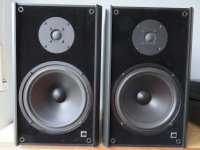 2 Arcus AS 4 Regal-Lautsprecher Boxen Hifi - MADE IN GERMANY (1).jpg199.7 KB · Views: 209
2 Arcus AS 4 Regal-Lautsprecher Boxen Hifi - MADE IN GERMANY (1).jpg199.7 KB · Views: 209 -
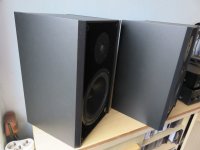 2 Arcus AS 4 Regal-Lautsprecher Boxen Hifi - MADE IN GERMANY (5).jpg149.5 KB · Views: 203
2 Arcus AS 4 Regal-Lautsprecher Boxen Hifi - MADE IN GERMANY (5).jpg149.5 KB · Views: 203 -
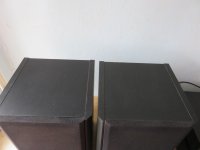 2 Arcus AS 4 Regal-Lautsprecher Boxen Hifi - MADE IN GERMANY (4).jpg135.1 KB · Views: 256
2 Arcus AS 4 Regal-Lautsprecher Boxen Hifi - MADE IN GERMANY (4).jpg135.1 KB · Views: 256 -
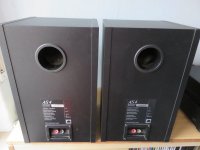 2 Arcus AS 4 Regal-Lautsprecher Boxen Hifi - MADE IN GERMANY (7).jpg163.9 KB · Views: 234
2 Arcus AS 4 Regal-Lautsprecher Boxen Hifi - MADE IN GERMANY (7).jpg163.9 KB · Views: 234 -
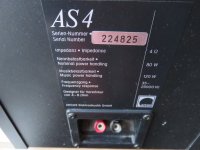 2 Arcus AS 4 Regal-Lautsprecher Boxen Hifi - MADE IN GERMANY (2).jpg209.2 KB · Views: 336
2 Arcus AS 4 Regal-Lautsprecher Boxen Hifi - MADE IN GERMANY (2).jpg209.2 KB · Views: 336
Last edited:
A few pictures I just found of the ARCUS AS 4 speaker.
Obviously it's a cheap speaker but plays fine.
Obviously it's a cheap speaker but plays fine.
Attachments
Last edited:
It needs a "squeaker" ! Or a tweeter with a waveguide to match dispersion at crossover.
It'll be always bass heavy if you don't balance the emissions of the drivers; 4 Ω woofer also calls for more power going trough it.
It'll be always bass heavy if you don't balance the emissions of the drivers; 4 Ω woofer also calls for more power going trough it.
The tweeter output is balanced, it doesn't feel like it's lower on output if I understand your point
Uhm...well...er...I was just following your reports 😱
An 8" and a 1" is a challenge. I once used a woofer similar to yours but together with at 2" ( Monacor SPX 20 ) and I used a woofer's membrane to make a waveguide. It works!
An 8" and a 1" is a challenge. I once used a woofer similar to yours but together with at 2" ( Monacor SPX 20 ) and I used a woofer's membrane to make a waveguide. It works!
It needs a "squeaker" ! Or a tweeter with a waveguide to match dispersion at crossover.
It'll be always bass heavy if you don't balance the emissions of the drivers; 4 Ω woofer also calls for more power going trough it.
In theory, yes - but not In practice.
There are some very highly regarded 2-way, 8" + 3/4" speakers that sound very well balanced. I'm quite fond of the Audio note K and the old JPW AP 2/3.
Thanks guys. I downloaded WinISD but don't know how to use it, I have to check how it Works.
The original cabinets are made of particle board, 19mm baffle, 15mm top, bottom and back and 25mm sides. It is filled with some polyester wool (not the port tube)
The tweeter is the SEAS 25TFF (H457) 6ohm and the woofer has a label on it writing: P20WN-01 04ohm 202 (but it's a VIFA)
Pictures (not mine)
IIRC that tweeter was used In the old Proac Studio 100. Also has film caps In the crossover and a Vifa woofer, so not bad for budget speaker.
I did quick google search but couldn't find the theile/small parameters for the woofer. Maybe an email to Vifa would be worth a try?
If no joy there, I'd build a bigger box than you think you'd need but with a removable back panel and experiment with different box volumes and port lengths (maybe put something In the box to temporarily take up space). Just model any old woofer In winISD and use that to give you an Idea of what will happen with different enclosure volumes and port lengths.
In an Ideal world you'd have the port as short as possible to reduce port resonances but try not to reduce the diameter of the port or you will risk port chuff.
Yes, the silk dome 25TFF was used in the Studio 100. It is very transparent ("silky treble")without any harshness. A few years ago when I bought the speakers I tried too to find any info of the Vifa woofer without luck. I guess it was custom made by Vifa for Arcus.
I'm thinking of your idea of removable back, I guess I have to experiment with a pair and compare that with the other non-modified pair.
I'm thinking of building the cabinets with 20 or 25mm Baltic Birch plywood instead of mdf / particle board, what do you think;
The WinISD is interesting but I have to study it to understand how to use it.
If the cabinet will be bigger does it matter if the extra volume will come with more depth (the port is at the back) without changing original height and width or should I change these as well going with some optimum dimension ratios, like these written in another thread:
1 : 1.14 : 1.39
1 : 1.26 : 1.59
1 : 1.28 : 1.54
1 : 1.44 : 2
1 : 1.60 : 2.33
1 : 1.62 : 2.63
I'm thinking of your idea of removable back, I guess I have to experiment with a pair and compare that with the other non-modified pair.
I'm thinking of building the cabinets with 20 or 25mm Baltic Birch plywood instead of mdf / particle board, what do you think;
The WinISD is interesting but I have to study it to understand how to use it.
If the cabinet will be bigger does it matter if the extra volume will come with more depth (the port is at the back) without changing original height and width or should I change these as well going with some optimum dimension ratios, like these written in another thread:
1 : 1.14 : 1.39
1 : 1.26 : 1.59
1 : 1.28 : 1.54
1 : 1.44 : 2
1 : 1.60 : 2.33
1 : 1.62 : 2.63
Last edited:
It could be that the vifa woofer is a standard unit that had It's name changed. Hard to tell without measuring t/s.
Baltic birch would be fine. Make sure you brace them well, especially either side of the woofer. You don't want the cabinet walls moving In and out when the woofer Is.
The crossover will be designed for the front baffle dimensions, so In an ideal world you'd keep those the same and extend the back. Most Important Is to keep the baffle width the same and the driver positions the same. Extending the length of the baffle (below the woofer) might not make much difference but I wouldn't want to bet on It. Jeff bagbys Diffraction and boundary simulator may help you here or The Edge.
Baltic birch would be fine. Make sure you brace them well, especially either side of the woofer. You don't want the cabinet walls moving In and out when the woofer Is.
The crossover will be designed for the front baffle dimensions, so In an ideal world you'd keep those the same and extend the back. Most Important Is to keep the baffle width the same and the driver positions the same. Extending the length of the baffle (below the woofer) might not make much difference but I wouldn't want to bet on It. Jeff bagbys Diffraction and boundary simulator may help you here or The Edge.
Great! Many thanks!
I will make new baffle with the same internal dimensions.
20 or 25mm thickness all around except back panel; Should I use 15mm thick back panel in order to have the same internal port length as originally was;
I will make new baffle with the same internal dimensions.
20 or 25mm thickness all around except back panel; Should I use 15mm thick back panel in order to have the same internal port length as originally was;
Keep the front external dimensions the same. Oh, port can go anywhere. I know it's unusual but I prefer to side mount it (look up Royd Minstrel)
STOP! Do not make a new cabinet! Old one is good enough. But, if there is too much bass, than stuff the bottom half (or two thirds) of the enclosure with some stuffing material like glass wool or polyester wadding. If that is not enough, put some of the material in the vent.I will make new baffle with the same internal dimensions.
20 or 25mm thickness all around except back panel
Stuffing the vent is a bad idea. You could try adding more stuffing to the box but it already looks pretty well stuffed. Always keep stuffing well away from the port.
IF there is too much bass than stuffing the vent IS a good idea, actually.
Manufacturer stuffed the box well for a reason, but maybe it is not enough.
Manufacturer stuffed the box well for a reason, but maybe it is not enough.
Just noticed your last question. Rear baffle thickness wont affect the port length.
The tube length will be the same but with a thicker rear panel the tube length inside the cabinet will be shorter, won't it;
Last edited:
STOP! Do not make a new cabinet! Old one is good enough. But, if there is too much bass, than stuff the bottom half (or two thirds) of the enclosure with some stuffing material like glass wool or polyester wadding. If that is not enough, put some of the material in the vent.
The original particle board panels are not firmly glued together. It was easy with a hammer to take them apart without breaking them. Cabinet looks solid but isn't that much after all.
- Status
- Not open for further replies.
- Home
- Loudspeakers
- Multi-Way
- Internal volume modification on original factory loudspeakers
